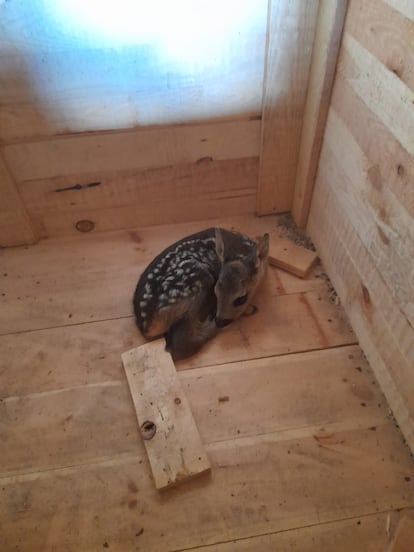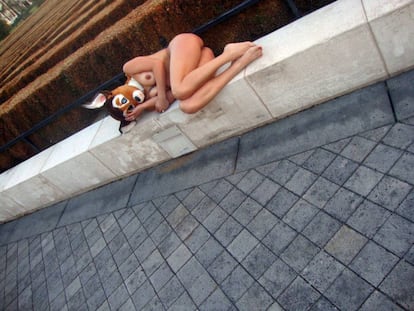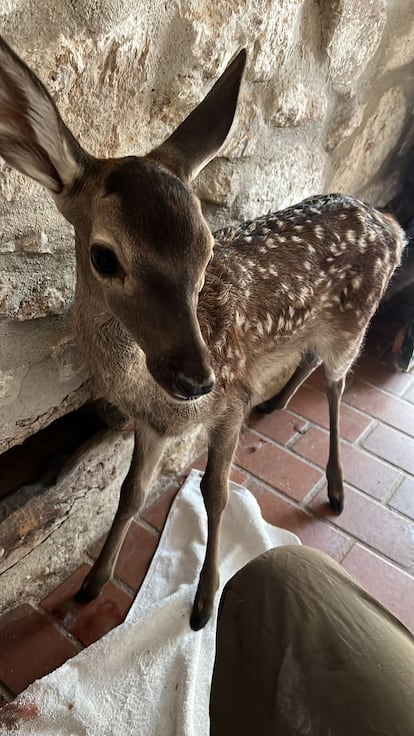With the cat, the snake, two turtles, six baby salamanders (five have already completed the metamorphosis and are fine, thank you: I will soon release them on the mountain) and 18 frozen mice in the refrigerator, in the vegetable drawer, For the snake, I thought my life was complicated when it came to fauna. But you can get into bigger trouble. This is what has happened to two good friends, Luis and Melina, who have encountered two deer: a roe deer calf and a deer calf, respectively.
Luis, a mature lawyer from Salamanca whom I met when we both met in a tent in Ngorongoro – which is already a place to make friends -, when we were both praying that the lion that was hovering around us would take the other one, sent me A few weeks ago a photo showed a roe deer, which is what baby roe deer are called. It was an adorable little bug, with white dots, pure Bambi. To annoy Luis, who likes to act like a tough guy like Bula Matari (“rock breaker”, Stanley’s nickname) but in reality is almost as endearing as a corcino, I replied to him on WhatsApp: “How cute, no! shoot him!” “At good times,” the joke continued, “for these moments here we use a blackjack.” In reality, a good connoisseur of wild fauna, Luis had done the most correct thing – I have seen in Jara and fishing line, which is what the Spanish Roe Deer Association (ACE) recommends, under the warning: “If you take it, it will die”—which is not to believe that they are abandoned and helpless, even if you see them lying motionless on the grass. “We found him when we saw the mother escape. We returned it quickly. So that she wouldn’t hate him. “Things about living in the country.”
The case of Melina, whom I met in Formentera (a much friendlier place, it must be agreed, than Ngorongoro, Melina is also friendlier compared to Luis) has been different. They found their Bambi (whom they have baptized Bamba) when the neighbor of the Cordoban farmhouse where they live brought them. “They were mowing and the thresher almost ran over him,” he explained to me. “He ran out and injured himself with part of the thorn that is used to separate fences.” And Melina wrote in a tone that was almost a sigh: she is a beauty. Let’s see if we can raise her (she is a girl) and we will let her loose with the donkey and the horse.” He sent me a wonderful video that would have left Gerald Durrell stunned, in which the creature, spotted and larger in size and with much larger ears than Luis’s corcino, was seen walking so calmly in the patio of Melina’s house while his daughter caressed her. My friend came to me for advice on how to care for the animal. It never ceases to amaze me how confident people who don’t see me every day have in my abilities.
I answered that I could help her with cats, snakes, turtles, salamanders and frozen mice, but that deer are something far away in my life and my only experience is having read as a child Chag the caribou, one of the titles by C. Bernard Rutley, from the author’s collection Life of Wild Animals published by the Molino publishing house (1968, 25 pesetas). He had also read the chapters on the chital, the barasingha and the sambar (the deer of India) in The Deer and the tiger, the classic study of the great George B. Schaller (The university of Chicago Press, 1967). And, as always, to prevent, the section on the danger of deer and relatives in Dangerous to man, by Roger Caras, one of my favorite books (Penguin, 1975). Fortunately, he dedicates many fewer pages to them than to crocodiles and sharks, although he notes the ordeal of a rancher from Wyoming (no, it was not Kevin Costner’s John Dutton) who narrowly escaped the charge of an elk that he threw at his packhorse off a cliff. “It is quite clear that any animal with hooves and antlers can be dangerous and you should approach them with caution, especially males during the mating season,” Caras sensibly emphasizes.
Anyway, since I could contribute little to Melina, I had the brilliant idea of putting her directly in contact with Luis, selfishly and secretly thinking that the more than likely lack of chemistry between them being so opposite would only strengthen the ties of friendship. that united each of them with me. Well, it turned out that they fell beautifully! The hunter and the animalist, take a fable! Auden already said that the human heart is very twisted. Let’s see if this is going to end like this The bridges of Madison, although Luis has reminded Melina more of Labordeta than of Clint Eastwood.
Luis, who has clarified that what Melina has is a baby deer, “a little cat,” has warned her, in a display of righteousness that honors him but that surprises me in an individual who once sent me several warthog tusks through mail in a package of white asparagus from Navarra, which, with the law in hand, cannot be had; but just in case he has given her a series of recipes to feed her. The fawn no longer drinks milk and eats grass.

And I, without a doe or a fawn, have turned to books in search of information and have chosen to Bambi (1923), the original novel by Felix Salten that gave rise to that film that has traumatized us all—even Tarantino, who looks like he has the endurance (in his Cinema meditations He says he thinks it’s harder than Wes Craven’s movies.) She had not read the book considering that she had already cried enough at the film version. And I have to admit that it surprised me a lot (I opted for the wonderful Catalan translation by Montserrat Camps Gaset for Adesiara, published last year and which has a very interesting and highly documented epilogue on the life and work of Salten). From the outset, I was impressed by the author’s personality. I thought that Salten (Pest, 1869-Zurich, 1945) must have been a writer of short stories, like the Brothers Grimm in one, but it turns out that he was an Austro-Hungarian guy very involved in Viennese literary and cultural life, who was a friend of Freud (the Bambi-Freud connection is very juicy) and by Arthur Schnitzler. He had it out with Karl Kraus, who considered that in another of the writer’s animal books, Fifteen rabbits (1929), story of a little boy called Earring —I have an old edition in Spanish, Story of fifteen haresBook Club, 1956, by the way it appears unexpectedly Bambi on page 82—the hares spoke like Jews, which Salten took badly, although Kraus was also Jewish. It seems that Kraus’s relationship with actress Ottilie Metz, who later married Salten, had more to do with it than the rabbits, and that’s true.
Born Siegmund (Zsiga in Hungarian) Salzmann, grandson of a rabbi and Zionist, Salten, who changed his name like other Jews who sought to assimilate into Viennese society, is the author of a very extensive work (more than 7,000 titles) of which the novels of animals are only a part and include other novels, poetry, stories, theater, opera scripts, journalistic texts, translations, film scripts and serials (the first version of Bambi appeared like this). Salten was a cultural promoter and supporter of artistic experimentation (Camps Gaset underlines this) who even participated in the foundation Theater zum lieben Augustin, a Viennese innovative theater cabaret.

Salten saw his entire world take on a dangerous brown hue with the Anschluss and, Freud-style, he left Vienna on foot for Switzerland. The Nazis burned all copies of Bambi that they could, which has always surprised me, because look, the Nazis had things to do. I read the book thinking about what things could bother Hitler and it seems to me that above all it would piss off Goering, the great master hunter of the Reich (Reichsjägermeister), if the protagonists were the animals and the hunter (“Him”, in the book). the villain. The novel is very different from the movie. Bambi is a roe deer and not a deer like Disney made him out to be. In fact, the Salten deer look at the larger deer with great respect. Flor is not a skunk (which does not come out: there are none in Europe) but a butterfly. The rabbit doesn’t come out either Tambor, but an unnamed friendly hare, and a squirrel, and a tawny owl, and a kingfisher! If the girlfriend comes out Bambi, Falinewith which he has a affair, but he ends up forgetting it. The death of her mother, who has already abandoned Bambi to go out again with her father, is no drama: she leaves the scene off-screen, after a hunt (“Bambi He never saw his mother again”, period).
Salten shows the life of nature in a much more realistic and harsh way than Disney, which reserved cruelty for us. Adult male deer, “the princes”, do not interact with their children. Bambi He establishes, however, an initiatory relationship of homoerotic (corzoerotic?) overtones with the Elder, the Great Prince, who indoctrinates him in the secrets of life. TO Bambi His horns sprout and he becomes quite rude, outgoing (“youthful strength swelled in Bambi”), dominant and violent, as male deer are. The danger of man, who has not only two hands but a terrible third (the shotgun) is omnipresent and keeps the forest community terrified. A friend of Bambi, Mushroom, is collected by man and returned to the forest as a collaborator. A dog kills a fox in a very cruel way. Bambi He ends up taking on the role of Prince of the Forest, but he is not at all likeable. In short, the novel is full of serious themes—Camps points out otherness, identity, rejection and anti-Semitism—and it is not the children’s story it would seem.
Bambi It had translations into Yiddish, French and English, in 1928, which was the one that reached Walt Disney, who immediately bought the rights for the film, which is, I didn’t remember it being that old, from 1945.

What surprised me most, apart from discovering that Salten was a passionate hunter, is that, in his multifaceted nature, he also wrote a pornographic novel: Memories of Josephine Mutzenbacher (1907). Well, it is actually attributed to him, but he never denied having written it, and scholars assume that he is the author. If the Nazis burned Bambi, nor am I telling you what they should have done with this one. The novel, in first person (I have obtained an edition in Spanish, Editores Americanos, 1975, it reads quickly), consists of the memories of a precocious prostitute, worthy of Sade’s pen, who introduces herself to sex at the age of seven years and she doesn’t stop until she becomes a whore of aúpa. The story is a succession of give-and-take erotic scenes of very low quality (sorry Felix, I had to say it). It is not advisable to read it while you are wearing Bambi.
Subscribe to continue reading
Read without limits
_

